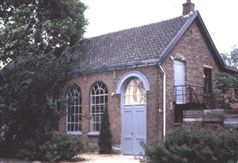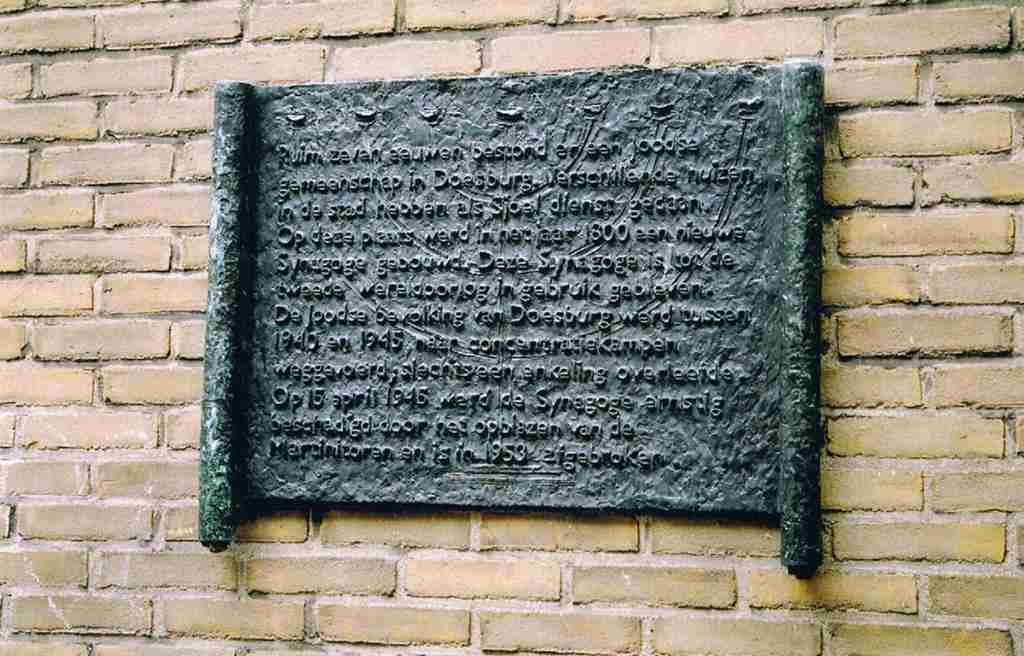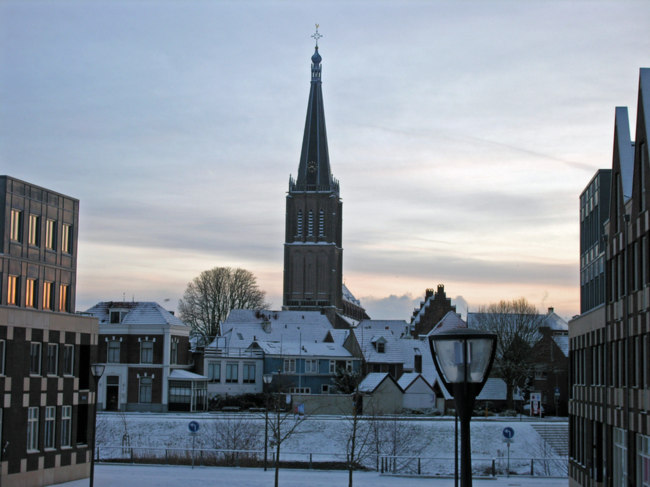The Jewish community of Doesburg
List of names of genealogical relevance mentioned in thearticle (in order of appearance):-
1) Till the end of the 18th century:
Godschalk son of Samuel (1185), Godschalck Isaac & Simon Levi (1639), Judith Samuel, Ephraim Godschalk, Salomon Daniels, (17th cent.), Abraham Salomon Heijman, Salomon Heijman, Roosken Mendels, Berend Ephraim, Beer Levi & Philip Beer Gomperts, Toltse Oppenheim, Philip Levi , David Levy Haas, Sara Abrahams, Moses Dikkop from Kalmar (robber chief), Levi & Judik Goltsmit, Levy Simons, Isac Jacobs and Gesellik Moises , Davidand Aron Levy Haas, Benediks, Franken, Goudsmidt, (18th cent.).
2) 19th century:
[Also part of the names mentioned in 1)]
Wolff, Levy, van Bingen, Groonheim(families), Religious education teachers:-Abraham Schlesinger, LevyGodschalk, Isaac Levie de Groote ( from Amsterdam), Salomon Goldstein, Manus van Dijk, Marcus Haalman, Nathan Koppens, Meijer Bierman, Benjamin Simons, Meijer Gazan, Leon Borstrok, Samuel van der Hal, Naftali Polack, Philip Hertz Cohen , Eleazar van Tijn.
4) 20th century (after the Second World War):
Chief Rabbi E. Berlinger
In a real estate registration, compiled in Cologne in 1185, appear the names of Godschalck, son of Samuel from Doesburg.
The occupation of these people is unknown. During the 14th century about 500 Jews fled from Brabant to Gelre.
About 1330 a Jewish family lived in Doesburg again.
In 1434 a Jewish street named "the Jooden - or Jeudenstraat," was changed into the Coesveltsstraat in the middle of the 18th century.
During the 15th century there seemed to be was a small Jewish community in this small Hanze (*) town.
It is known that in 1663 there was the "Corte Joodenstraat," – the short Jewish Street.
(*)-A hanze was a league of cooperation between merchants and towns during the Middle Age.
Thus cooperating they tried to defend their trade interests or expanding them.
The pawnshop
In 1639 Godschalck Isaac and Simon Levi from Amsterdam received a permit to manage the pawnshop in Doesburg, against a payment of 100 guilder rent money. In the same year they received a “patent” (called an octroi), signed by the mayor, aldermen and councilors, confirming, among other things, that they together with their families and goods were allowed to live in the town.
Certain provisions were stipulated, regarding blasphemy and the burial of their dead .
The agreement included the following:"That we, upon the humble request of Godsch(alck) Isaac and Sijmen Levi, Jews, all of them together and each one of them separately,have favorably consented and authorized, like we consent and authorize amongst these people, that they with their family and the goods owned by them, may establish their residence and their living quarters within this town of Doesborch and hold same for a period of six years, one year following the other, from which the first year will start from St. Gall this year 1639."
(Holiday in honor of St. Gall, Catholic saint around 600 A.D.)
Furthermore:"Besides, the Jews holding this octroi should be very careful not to utter any form of blasphemy and slander against our Savior Jesus Christ,or against those confessing their Christian belief, and they also shall confess their religion without causing annoyance to anybody, thereby being liable to the annulment of their octroi, with fitting punishment.
In the margin the following was written: "In case Jews or anyone of them, their housewives or family during the period of their octroi will come to die, so shall we reserve for them an honest place where they may bury their dead in accordance with their own custom, without any intervention by anybody."Further privileges included exemption from guard duty for the garrison and from the de-icing of the canals.
Simon Levi, married to Judith Samuel, ran the pawn shop for the longest period, for forty four years.
Ephraim Godschalck, son of the first pawnshop holder, became in 1675 the partner of Simon Levi. The latter passed away in 1683.
In 1673 Ephraim Godschalck started a process against his partner Simon Levi. It turned out that Simon, in front of the door of the pawnshop, had insulted the 27 year old Salomon Daniels, one of their clients, as being a knave.
Ephraim had interfered with the quarrel and the hotheaded Simon had, out of rage, injured Ephraim by causing him an open wound by hitting him over the head with a stick. Simon's punishment is unknown, but in any case Ephraim and Simon exploited the pawnshop for another ten years, notwithstanding the process.
In 1702 Abraham Salomon Heijman came to live in Doesburg. He was the successor of Salomon Heijman and he managed the pawnshop after Salomon between 1706 till 1717. He also started immediately a small tobacco shop, compelling him to borrow money. He obviously was a bit slow with repayments,as became clear from countless judicial procedures. He was certainly not popular, since in 1716 an angry creditor hit him with a hunting knife.
The pawnshop holder was wounded and for some time was unable to execute his profession.
In 1702 he borrowed 100 guilders, which were claimed by the heirs in 1714. He also had a dispute with a farmer, who had sold him a cow, but they were unable to agree about the price, so a clerk had to give his decision. He was convicted and severely punished.
In September 1709 Roosken Mendels, Abraham's wife, insulted Berend Ephraim during prayers. She accused him of having stolen a silver "jad" from the Holy Arkand also of having acted as a fence for stolen goods.
As a result of all this confusion and turmoil with regard to his misdeeds – done or not – he was finally incarcerated in 1723.
Beer Levi and Philip Beer Gomperts (from the famous bankers family from Kleef) acted as the one before the last Jewish pawnshop holders in Doesburg.
It was stipulated that they would be authorized to fix the opening hours of a " house fitted" for the loan bank.
In 1738 it was also stipulated that on a loan "of each thaler they would raise interest of half a penny per month and for amounts above five hundred guilders,not more than twelve percent per year."
In the agreement it was mentioned moreover that members of the family and their servants, would be buried in the Jewish cemetery, without any extra fees being due to the town.
On 2 March 1740 Philip Beer Gomperts and his wife, Toltse Oppenheim, bought a house and courtyard in the Koepoortstreet in order to establish their loan bank there, managed by him till 1754. Then his son Philip Beer took over the management of the business.
In 1780 he had a dispute with the baroness of Palandt, the owner of the neighboring house, who had ordered to make a hole in the wall of the loan bank in order to affix a beam there. Philip Levi registered a protest against her, because it dimmed the light in the pawn room.
He won the process and the baroness had to pay the costs of process and to remove the beam within 24 hours.
The last Jewish owner of the pawnshop was David Levy Haas, married to Sara Abrahams. He managed the business from 1798 till 1802, when the pawnshop passed to the Hervormde community in Doesburg.
Robber gangs
During the 18th century and during the first half of the 19th century, organized robber gangs operated in the border region between Holland and Prussia. Sometimes these gangs were comprised of Jews only, but usually those were mixed groups of Jews and Christians.
During the first quarter of the 18th century a very active gang, with Jewish members, made the roads of Gelderland, Overijssel and the border region unsafe.
In Doesburg two members of the gang were arrested. Benjamin, one of the chiefs, and the former owner of the pawnshop, Abraham Salomon Heijman.
Benjamin had been ordered by captain Moses Dikkop from Kalmar to go to Doesburg in order to prepare a heist from the priest in Steenderen.
In 1722 Abraham Salomon got acquainted with Moses Dikkop.
It was told that Moses said to Abraham: "What do you earn from walking with such a heavy pack, you are not able to earn more than five or six pennies a day, can you not show me, here or there, where I can find a good catch?" Abraham Salomon had sworn on the Torah that he would not betray the gang.
So, the holder of the loan bank, who already went downhill to the status of a peddler who did not pay his debt, became, even worse, a lower criminal informer.
Abraham Salomon was about to effect the heist together with Benjamin, but a farmer discovered the plot and warned the court officials.
Abraham confessed immediately but Benjamin denied any guilt. He was judged in Doesburg, sentenced to torture on "the wheel" and decapitated.
Abraham Salomon's fate was somewhat better. He was flogged, branded and afterwards he had to spend twelve years in the work house in Arnhem.
His wife Roosken and her children had to leave Doesburg.
The robbery affairs in Zwolle and Doesburg continued to keep the minds busy for many years.
The "Gelderse Authorities" published in 1726 a provincial resolution, forbidding Jews to live in the countryside.
The resolution included a characteristic sentence: "Experience teaches us, that repeated thieveries, burglaries and armed violence by people coming together, who under horrible threat, gagging and inhuman mistreatment of the good inhabitants of the countryside, deeds especially done by the Jews or Smouses, coming from different regions,and sometimes even from unbelievable far distances, some with company and others one after the other, to a place at a time, at joint appointment, in order to effect their inhuman violence."
After the remarkable public execution, torture and branding in 1723, these kinds of punishments were not executed anymore in de Liemers and the Achterhoek.
Eighteenth century
At the start of the 18th century the families Goltsmit, Levy Simons, Isac Jacobs and Gesellik Moises lived in Doesburg.
Levi and Judik Goltsmit had a small shop in "sits," a kind of paper, and cotton.
During this period many problems arose between the Jews and the authorities. During 1762 and 1776 the authorities issued many rulings, some of them guarding the Jews, but usually restricting their trade.
In 1762 ordered the municipality "that no Jewish family, when celebrating their marriage ceremony or when confessing their religion, should be the cause of any insolence, on penalty of six old "shields," or calling after the Jews on penalty of two town guilders ."
In 1775 came the prohibition that foreign Jews were not allowed to occupy the profession of stocking-dyer.
In 1776 the Jews were forbidden to sell their merchandise on the weekly market and, upon request of a guild member, policemen were allowed to search Jewish homes, to check whether forbidden merchandise was hidden by them.
However, about 1778 David and Aron Levy Haas received a permit to open a shop and they were also allowed to occupy the profession of peddler.
Freedom equality and fraternity
The French troops, invading the Netherlands in 1795, were expected to bring with them the French ideals of freedom equality and fraternity.
In September 1796 the National Assembly decreed:
"No Jew shall be deprived of any rights or benefits, linked to the "Batavian citizenship."
It would take some years, before these ideals materialized in laws and regulations.
Only in 1811 did the Department of Upper-IJssel announce, that from now on no distinction would be made between Jews and non-Jews.
Moreover Jews were allowed to occupy all professions, without being disturbed by the guilds.
In 1798 the following families lived in Doesburg: Benediks, Franken, Goudsmidt, Haas, Miss Marcus and the widow Gomperts.
In 1808 King Louis Bonaparte ordered the Jews to adopt family names. The Jews did not take this decree very seriously, and some took the strangest names, like: Agsteribbe, Zomerplaag en Eitje.
The synagogues
At the start of the 18th century there was quite a lot of squabbling in the home synagogues of the time.
It is likely that the Jews held their services in a room in the house of loan bank holder Salomon Heijman and of his son Abraham Salomon Heijman.
On 5 May 1800 Wolff, Levy, van Bingen en Groonheim bought a small house at the corner of the cemetery, which would serve as a synagogue.
In February 1807 a heavy storm blew the roof off the synagogue by a heavy storm. The walls were also quite damaged.
The kehilla was permitted to go around town with "a satchel." Even in 1808 the collection had to be continued, and only in 1810 enough funds were collected to rebuild the small synagogue.
Five more Jews, living in Dieren, Spankeren en Soeren, belonged to the kehilla of Doesburg.
In 1848 the synagogue had become dilapidated; the kehilla was without funds, the provincial authorities did not give one cent and therefore all members had to empty their pockets in order to effect the most necessary repairs.
Only in 1905 a mikwe was added tot the synagogue.
The little synagogue served the community for almost 140 years.
In 1893 a new torah scroll was added. A festive evening with ball afterwards, was so appreciated, that a society was erected under the name "Sholoum We'reioes," peace and friendship.
In 1898 the synagogue was rebuilt and restored. About 1920 the building was somewhat expanded and a separate entrance was added for the mikwe.
The last service took place in 1939.
During the second world war part of the silver belonging to the synagogue and the Torah scrolls, were sent to Amsterdam.
In 1945 the synagogue was ruined through an act of the Germans. They blew up the tower of the adjacent Martini church , and the spire fell on the synagogue. The ruin stayed on until 1953.
Part of the Judaica of the kehilla of Doesburg is on view in the town museum The Red Tower.
The Jewish school
Rabbi Mozes was one of the first Jewish teachers in Doesburg. He probably taught in the house synagogue of Abraham Salomon Heijman.
Abraham Schlesinger was chazzan and teacher, probably already in 1788. About 1811 he was followed by the elderly Levy Godschalk.
In 1828 the chazzan Isaac Levie de Groote from Amsterdam, was nominated by the board of the kehilla as chazzan, Jewish teacher and sjocheet for the "kosher cutting." He would occupy this profession for forty four years.
In order to supplement his meager salary - he had a wife and eight children - he earned some extra money as a rag merchant and peddler.
Many descendants of Rabbi de Groote remained in Doesburg and many of them were murdered by the Nazis.
Other Jewish teachers were: Salomon Goldstein, serving two terms, Manus van Dijk, Marcus Haalman, Nathan Koppens, Meijer Bierman, Benjamin Simons, Meijer Gazan, Leon Borstrok, Samuel van der Hal, Naftali Polack, Philip Hertz Cohen en Eleazar van Tijn.
The cemeteries
As mentioned before, the magistrate allocated in 1639 a plot for a cemetery for the use of the loan bank holders and family members.
In 1662 Simon Levy and his wife Judith Samuel bought half a courtyard for use as a cemetery.
In 1672 the existence of a cemetery was noted in an official act "straight behind and at the wall of her "Cloosterhoff,"
one side touching the Jewish cemetery." This small cemetery was situated near the Ooiportwal.
The town scribe noted in 1700 that "Willem Schaep had been authorized by Ephraim (Godschalck) that Abraham (his brother?) ,Jew, shall be condemned to pay for these burial plots 50 guilders."
In 1723 the kehilla received permission to open a second cemetery near the Vheerport.
When also there no place was left, a new location was found near the Bresserwal. After approximately 80 years, the second Jewish cemetery, called the Joodenbult, became also "occupied with enough corpses" as written by the parnas B.D. Wolff to the municipality.
Then the kehilla obtained a parcel of city land. This cemetery was composed of two parts, in the form of the letter L.
When that cemetery was also full the kehilla obtained in 1854 a parcel near the Orphanage, against a yearly compensation of three guilders.
The new cemetery was constructed alongside the Kraakselaan with a capacity of 154 graves.
In 1919 a local paper reported a complaint regarding the destruction of the metaar house. The kehilla had to hold a collection in order to repair the damage.
During the same year the orphanage again allocated a parcel of ground. The cemetery remained in use till 1963.
In the thirties of the previous century the old cemeteries near the Ooiportwal and the Vheerportwal were already very neglected.
Since after 1945 there lived only a few Jewish families in Doesburg and after the kehilla of Doesburg was annexed to Arnhem in 1947, these cemeteries were vacated and the remains and one tombstone were transferred to the Kraakselaan, under supervision of the chief rabbinate.
This Beit Hahaim at the Kraakselaan had been heavily damaged during the war and during the fifties the damage had been aggravated by children of the neighborhood.
Tombstones and the metaar house suffered most of the damage.
Because the Doesburg municipality wanted to use the ground for building, all remains and tombstones were moved to the Jewish cemetery at the IJkenbergerwegin Doetinchem, with the consent of Chief Rabbi E. Berlinger.
Source:
Het Oude Volk Kroniek van joods leven in de Achterhoek, Liemers en het grensgebied-Staring Instituut/Mr.H.J.Steenbergenstichting
by Hans Kooger
Doetinchem, 2001, pag.282 till 294 with 73 reference notes
Extracted from source:Yael (Lotje) Ben Lev-de Jong
Translation from Dutch:Mechel Jamenfeld
End editing English:Hanneke Noach
Coordinating of final version:Ben Noach
[an error occurred while processing this directive]
[an error occurred while processing this directive]
 The Synage of Doesburg
The Synage of Doesburg
The Plaquette
